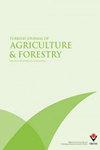采后亚精胺处理对油桃果实品质及生化特性的影响
IF 3
2区 农林科学
Q1 AGRONOMY
引用次数: 1
摘要
本研究测定了采后不同剂量亚精胺(SP)处理对油桃果实果理化成分变化的影响。在4±0.5°C、90±5% RH条件下冷藏30 d。用高效液相色谱法分析生化化合物中特定有机酸和酚类化合物。作为油桃果实质量指标的失重值和腐烂值在贮藏期比采收期有所增加。在本研究中,1.0 mM SP的应用被发现在贮藏过程中更成功地保存了视觉质量(果肉硬度和重量减轻)特性。贮藏期结束(第30天),对照组体重下降3.27%,1.5 mM SP处理体重下降1.84%。果实果肉硬度值是影响果实贮藏寿命的重要品质参数之一,对照组为30.97 N, 1.5 mM SP睡眠(30 d)为37.06 N。与酸度值相反,总可溶性固形物含量(TSS)和果汁pH值在储存过程中增加。在本研究中,对有机酸和酚类化合物的含量进行了检测;结果表明,油桃果实中主要有机酸和酚类化合物分别为苹果酸和绿原酸。30 d贮藏结束时,对照组苹果酸含量为4.89 g/kg, 1.5 mM SP处理苹果酸含量为6.66 g/kg。贮藏结束(30 d)时,对照组绿原酸含量为6.86 mg/100g, 1.5 mM SP组绿原酸含量为8.82 mg/100g。本研究确定采后1.5 mM的SP对油桃果实的生化成分有较好的影响,在贮藏过程中对油桃果实的保护作用更强。本文章由计算机程序翻译,如有差异,请以英文原文为准。
Effect of postharvest spermidine treatments on quality and biochemical properties of nectarine fruits
: In this study, the effect of spermidine (SP) treatments at different doses after harvest on the changes in the pomological and biochemical contents of nectarine fruits was determined. The fruits were placed in cold storage (4 ± 0.5 °C and 90 ± 5% RH) for 30 days. Specific organic acids and phenolic compounds from biochemical compounds were analyzed by HPLC device. Weight loss and decay values, which are quality criteria of nectarine fruits, increased during storage compared to the harvest period. In this study, 1.0 mM SP application was found to be more successful in the preservation of visual quality (fruit pulp firmness and weight loss) properties during storage. At the end of the storage period (30th day), weight loss was determined as 3.27% in the control group and 1.84% in the 1.5 mM SP treatment. Fruit flesh firmness value, which is one of the important quality parameters affecting the storage life of fruits, was determined as 30.97 N in the control group and 37.06 N in 1.5 mM SP doze (30th day). Contrary to the acidity values, the total soluble solids content (TSS) and fruit juice pH values increased during storage. In this research, when the organic acid and phenolic compound contents are examined; it was determined that the dominant organic acid and phenolic compound in nectarine fruits were malic acid and chlorogenic acid, respectively. The malic acid ratio was found to be 4.89 g/kg in the control group and 6.66 g/kg in 1.5 mM SP treatment at the end of the 30-day storage period. Chlorogenic acid content was recorded as 6.86 mg/100g in the control group and 8.82 mg/100g in 1.5 mM SP application at the end of the storage period (30th day). In this study, it was determined that a 1.5 mM SP dose after harvest was effective on the biochemical contents of nectarine fruits and protected the fruits more during storage.
求助全文
通过发布文献求助,成功后即可免费获取论文全文。
去求助
来源期刊
CiteScore
4.20
自引率
6.90%
发文量
42
审稿时长
12 months
期刊介绍:
The Turkish Journal of Agriculture and Forestry is published electronically 6 times a year by the Scientific and Technological Research Council of Turkey (TÜBİTAK).
It publishes, in English, full-length original research papers and solicited review articles on advances in agronomy, horticulture, plant breeding, plant protection, plant molecular biology and biotechnology, soil science and plant nutrition, bionergy and energy crops, irrigation, agricultural technologies, plant-based food science and technology, forestry, and forest industry products.

 求助内容:
求助内容: 应助结果提醒方式:
应助结果提醒方式:


